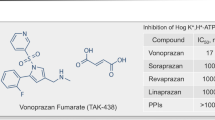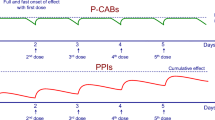Abstract
Acid-related disorders are common management problems in clinical practice. The key to effective management is successful suppression of gastric acid production. Proton pump inhibitors (PPIs) are the most potent acid suppressants available and are significantly more effective than histamine H2 receptor antagonists. Although PPIs are highly effective as a class, differences in their pharmacokinetics, such as bioavailability, elimination half-life and metabolism, may translate into differences in clinical outcomes. A new immediate-release omeprazole has been introduced, which allows rapid absorption. This has been shown to produce significantly better nocturnal gastric acid control than delayed-release tablets. The bioavailability of rabeprazole on day 1 is greater than with other PPIs, and this may translate into faster onset of symptom relief for patients with gastro-oesophageal reflux disease. On the other hand, the bioavailability of esomeprazole increases 3-fold at day 5, and it has been shown that on day 5, esomeprazole provided significantly more effective control of gastric acid than other PPIs. The exact clinical significance of these observations remains to be determined. There is genetic polymorphism in PPI metabolism via cytochrome P450 2C19. In Helicobacter pylori eradication, a significantly lower eradication rate was seen in extensive metabolisers with omeprazole and lansoprazole but not with rabeprazole. The oesophagitis healing rate was lower in extensive metabolisers with lansoprazole but not with rabeprazole. The currently available PPIs have short elimination half-lives ranging from 1 to 1.5 hours. Tenatoprazole is a new PPI that has a 5- to 7-fold longer elimination half-life than current PPIs. It could be potentially more useful for the treatment of gastro-esophageal reflux disease and nocturnal acid breakthrough than other PPIs.


Similar content being viewed by others
Notes
The use of trade names is for product identification purposes only and does not imply endorsement.
References
Burget DW, Chiverton SG, Hunt RH. Is there an optimal degree of acid suppression for healing of duodenal ulcers? A model of the relationship between ulcer healing and acid suppression. Gastroenterology 1990; 99: 345–51
Howden CW, Jones DB, Peace KE, et al. The treatment of gastric ulcer with antisecretory drugs: relationship of pharmacological effect to healing rates. Dig Dis Sci 1988; 33: 619–246
Bell NJ, Burget D, Howden CW, et al. Appropriate acid suppression for the management of gastroesophageal reflux disease. Digestion 1992; 51 Suppl. 1: 59–67
Lin H-J, Lo W-C, Lee F-Y, et al. A prospective randomized comparative trial showing that omeprazole prevents rebleeding in patients with bleeding peptic ulcer after successful endoscopic therapy. Arch Intern Med 1998; 158: 54–8
Chiba N, De Gara CJ, Wilkinson JM, et al. Speed of healing and symptom relief in grade II to IV gastroesophageal reflux disease: a meta-analysis. Gastroenterology 1997; 112: 1798–810
Vigneri S, Termini R, Leandro G, et al. A comparison of five maintenance therapies for reflux esophagitis. N Engl J Med 1995; 333: 1106–10
Yeomans ND, Tulassay Z, Juhasz L, et al. A comparison of omeprazole with ranitidine for ulcers associated with nonsteroidal anti-inflammatory drugs. N Engl J Med 1998; 338: 719–26
Leontiadis GI, Sharma VK, Howden CW. Proton pump inhibitor treatment for acute peptic ulcer bleeding. Cochrane Database Syst Rev 2006 Jan 25; (1): CD002094
AstraZeneca. Nexium® prescribing information [online]. Available from URL: http://www.nexium.net/hcp/AboutNexium/Nexium-prescribing-information.aspx?mid=26 [Accessed 2007 Sep 25]
TAP Pharmaceutical Products Inc. Prevacid® prescribing information [online]. Available from URL: http://www.prevacid.com/pi.aspx [Accessed 2007 Sep 25]
AstraZeneca. Prilosec® (omeprazole) delayed release capsules [online]. Available from URL: http://www.astrazeneca-us.com/pi/Prilosec.pdf [Accessed 2007 Sep 25]
Wyeth Pharmaceuticals Inc. Protonix® (pantoprazole sodium) delayed-release tablets [online]. Available from URL: http://www.pantoprazole.com/ [Accessed 2007 Sep 25]
Eisai Inc. Aciphex® (rabeprazole sodium) delayed-release tablets [online]. Available from URL: http://www.aciphex.com/pdf/aciphexpi.pdf [Accessed 2007 Sep 25]
Bastaki SM, Chandranath I, Garner A. Comparison of five antisecretory agents acting via gastric H+/K+-ATPase. J Physiol Paris 2000; 94: 19–23
Sachs G, Shin JM, Howden CW. Review article: the clinical pharmacology of proton pump inhibitors. Aliment Pharmacol Ther 2006; 23 Suppl. 2: 2–8
Äbelö A, Andersson T, Antonsson M, et al. Stereoselective metabolism of omeprazole by human cytochrome P450 enzymes. Drug Metab Disp 2000; 28: 966–72
Andersson T, Hassan-Alin M, Hasselgren G, et al. Pharmacokinetic studies with esomeprazole, the (S)-isomer of omeprazole. Clin Pharmacokinet 2001; 40: 411–26
Ishizaki T, Horai Y. Review article: cytochrome P450 and the metabolism of proton pump inhibitors — emphasis on rabeprazole. Aliment Pharmacol Ther 1999; 13 Suppl. 3: 27–36
Howden CW. Review article: immediate-release proton-pump inhibitor therapy —potential advantages. Aliment Pharmacol Ther 2005; 22 Suppl. 3: 25–39
Castell D, Bagin R, Goldlust B, et al. Comparison of the effects of immediaterelease omeprazole powder for oral suspension and pantoprazole delayed-release tablets on nocturnal acid breakthrough in patients with symptomatic gastroesophageal reflux disease. Aliment Pharmacol Ther 2005; 21: 1467–74
Hellstrom PM. Vitols S. The choice of proton pump inhibitor: does it matter? Basic Clin Pharmacol Toxicol 2004; 94: 106–11
Pantoflickova D, Dorta G, Ravic M, et al. Acid inhibition on the first day of dosing: comparison of four proton pump inhibitors. Aliment Pharmacol Ther 2003; 17: 1507–14
Lind T, Rydberg L, Kyleback A, et al. Esomeprazole provides improved acid control vs omeprazole in patients with symptoms of gastroesophageal reflux disease. Aliment Pharmacol Ther 2000; 14: 861–7
Miner P, Katz PO, Chen YS, et al. Gastric acid control with esomeprazole, lansoprazole, omeprazole, pantoprazole, and rabeprazole: a five-way crossover study. Am J Gastroenterol 2003; 98: 2616–20
Fock KM, Teo EK, Ang TL, et al. Rabeprazole vs esomeprazole in non-erosive gastro-esophageal reflux disease: a randomized, double-blind study in urban Asia. World J Gastroenterol 2005; 11: 3091–8
Lim PWY, Goh KL, Wong BCY. Review article: CYP2C19 genotype and the PPIs — focus on rabeprazole. J Gastroenterol Hepatol 2005; 20: S22–8
Furuta T, Shirai N, Sugimoto M, et al. Effect of concomitant dosing of famotidine with lansoprazole on gastric acid secretion in relation to CYP2C19 genotype status. Aliment Pharmacol Ther 2005; 22: 67–74
Kawamura M, Ohara S, Koike T, et al. The effects of lansoprazole on erosive reflux esophagitis are influenced by CYP2C19 polymorphism. Aliment Pharmacol Ther 2003; 17: 965–73
Ariizumi K, Ohara S, Koike T, et al. The therapeutic effects of rabeprazole at a dose of 10mg on reflux esophagitis may not be influenced by CYP2C19 polymorphism [abstract]. Gastroenterology 2004; 126 Suppl. 2: 340
Furuta T, Ohashi K, Kamata T, et al. Effect of genetic differences in omeprazole metabolism on cure rates for Helicobacter pylori infection and peptic ulcer. Ann Intern Med 1998; 129: 1027–30
Schwab M, Schaeffeler E, Klotz U, et al. CYP2C19 polymorphism is a major predictor of treatment failure in White patients by use of lansoprazole-based quadruple therapy for eradication of Helicobacter pylori. Clin Pharmacol Ther 2004; 76: 201–9
Hokari K, Sugiyama T, Kato M, et al. Efficacy of triple therapy with rabeprazole for Helicobacter pylori infection and CYP2C19 genetic polymorphism. Aliment Pharmacol Ther 2001; 15: 1479–84
Kawai T, Kawakami K, Kataoka M, et al. Comparison of efficacy of dual therapy and triple therapy using rabeprazole in second-line eradication of Helicobacter pylori in Japan. Aliment Pharmacol Ther 2006; 24 Suppl. 4: 16–22
Kurzawski M, Gawrońska-Szklarz B, Wrześniewska J, et al. Effect of CYP2C19*17 gene variant on Helicobacter pylori eradication in peptic ulcer patients. Eur J Clin Pharmacol 2006; 62: 877–80
Suzuki T, Matsuo K, Sawaki A, et al. Influence of smoking and CYP2C19 genotypes on H. pylori eradication success. Epidemiol Infect 2007; 135: 171–6
Sheu BS, Kao WA, Cheng HC, et al. Esomeprazole 40mg twice daily in triple therapy and the efficacy of Helicobacter pylori eradication related to CYP2C19 metabolism. Aliment Pharmacol Ther 2005; 21: 283–8
Gawronska-Szklarz B, Wrzesniewska J, Starzynska T, et al. Effect of CYP2C19 and MDR1 polymorphisms on cure rate in patients with acid-related disorders with Helicobacter pylori infection. Eur J Clin Pharmacol 2005; 61: 375–9
Klotz U, Treiber G, Schwab M. Determinants of non-response in Helicobacter pylori eradication trials. J Gastroenterol Hepatol 2005; 20: 1471
Manes G. Helicobacter pylori eradication, CYP2C19 and omeprazole doses. Aliment Pharmacol Ther 2005; 22: 273–4
Chen MC, Hu CT, Wang LY, et al. The efficacy of Helicobacter pylori eradication related to CYP2C19 metabolism. Aliment Pharmacol Ther 2005; 22: 274–5
Padol S, Yuan YH, Thabane M, et al. The effect of CYP2C19 polymorphisms on H. pylori eradication rate in dual and triple first-line PPI therapies: a meta-analysis. Am J Gastroenterol 2006; 101: 1467–75
Furuta T, Sagehashi Y, Shirai N, et al. Influence of CYP2C19 polymorphism and Helicobacter pylori genotype determined from gastric tissue samples on response to triple therapy for H. pylori infection. Clin Gastroenterol Hepatol 2005; 3: 564–73
Furuta T, Shirai N, Kodaira M, et al. Pharmacogenomics-based tailored versus standard therapeutic regimen for eradication of H. pylori. Clin Pharmacol Ther 2007; 81: 521–8
Scarpignato C, Pelosini I. Review article: the opportunities and benefits of extended acid suppression. Aliment Pharmacol Ther 2006; 23 Suppl. 2: 23–34
Galmiche JP, Des Varannes SB, Ducrotte P, et al. Tenatoprazole, a novel proton pump inhibitor with a prolonged plasma half-life: effects on intragastric pH and comparison with esomeprazole in healthy volunteers. Aliment Pharmacol Ther 2004; 19: 655–62
Hunt RH, Armstrong D, James C, et al. Effect on intragastric pH of a PPI with a prolonged plasma half-life: comparison between tenatoprazole and esomeprazole on the duration of acid suppression in healthy male volunteers. Am J Gastroenterol 2005; 100: 1949–56
Acknowledgements
No sources of funding were used to assist in the preparation of this review. The authors have no conflicts of interest that are directly relevant to the content of this review.
Author information
Authors and Affiliations
Corresponding author
Rights and permissions
About this article
Cite this article
Fock, K.M., Ang, T.L., Bee, L.C. et al. Proton Pump Inhibitors. Clin Pharmacokinet 47, 1–6 (2008). https://doi.org/10.2165/00003088-200847010-00001
Published:
Issue Date:
DOI: https://doi.org/10.2165/00003088-200847010-00001




